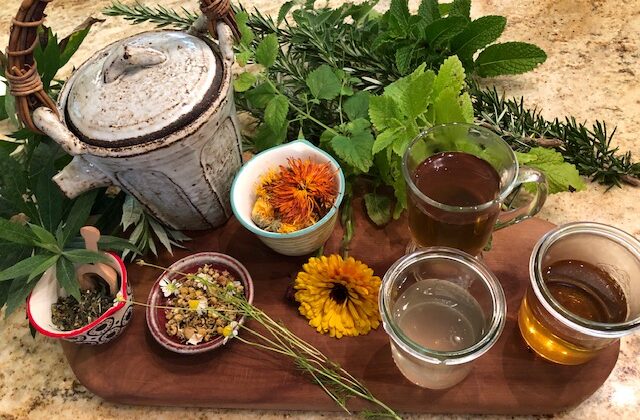私が3歳くらいかな、祖母の家に行くと玄関前にあった土手際に猫の額くらいの小さなお庭があったのを覚えている。おばあちゃんの気持ちと愛で育てられた野菜やお花たちは元気で私たちの食卓に使われるのを嬉しそうにしていた。
人間は曇りの日や雨の日ちょっと落ち込んだり悲しくなるけど、お天気がいい日、曇り空の日、雨の日も毎日少し育って、楽しそうにいる植物の力って凄いなと思った。
おあばちゃんは近所の人たちに少しヒーリンワークをしてた。疳の虫で夜中泣き止まない赤ちゃんや産後うつ病やホルモンバンランスを崩した女性がよく来ていた。山に野草·薬草や木の子を探しに行くのに連れて行ってもらった記憶もある。
いつか自分のお庭が持ちたい、野草·薬草を探しに行きたいとずっと願ってた。
7歳の時に近所の市場でリンゴの木箱をもらって猫の額より小さいお花ガーデンを借家の前に作った。自分ではとってもうまくできて花が咲いた時の感動は涙がでるくらいだったから通る人たちからたくさんきれいだと喜んでもらえたのが嬉しかったな〜。
それから、どんなところに住んでいてもいつも植物を育てていた。小さな鉢を大学の寮の窓側においたり、ゲストハウスを借りていた時期はプラスティックの植木鉢で50個以上のプラントを育てていた。
今、住んでいるサンタモニカの家に1985年に引っ越して、芝生の庭を竹とハーブの自然風ガーデンに作りかえた。
家の前の歩道のところもカリフォルニアのネイティブハーブを植えて屋上にはコンテイナーガーデンを作って薬草を育てている。
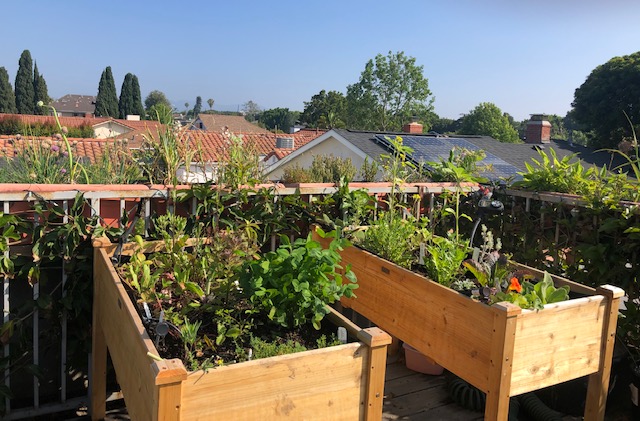
たくさんの鳥さんたち、蝶々さんたち、蜂さんたち、イモムシさんたち、てんとう虫さんたち、リスさんたちがお庭で楽しんでハミングバードさんたちとドーブ鳥さんたちが巣を作ってる。
1995年にハーブ学をディヴィッドクロウ氏(アメリカで有名なアロマセラピーの会社Floracopeiaオーナー)からカリフォルニアーヒーリンアート大学で学びました。カリフォルニアネイティブハーブと薬草の事をたくさん学んでハイキングに行ったりしてどのハーブか見分けができるようになり薬草を探せるようになり嬉しかった。マクロビオティック同様に薬草の事を長い事勉強して自分の生活に使ってきて本当に良かったなと思う。
特にカリフォルニアのネイティブハーブや薬草、薬花でレメディードリンクを作ったりスキンケアーのオイルをそして痛みに効くクリームを作るのが好き。
いつか私がしてきているのをみなさんにシェアーできたらと願いがあった。
1985年から近所のメリヒューサンセットガーデン(1947年から営業している植木屋さん)に行っているのだが、最近新しい若いオーナーのフランクとアティに変わった。二人は私のしている事にすごく興味を持ってくれてなんと私の願いが叶ってクラスをする事になった。

クラスは:
お家で育てられる薬草茶(レメディ)作り
日にち:6月18日(土)
時間:午前11時から午後12時
料金:一人$40
場所:メリヒューサンセットガーデン
1526 Ocean Park Boulevard
Santa Monica, CA 90405
クラスは野外ですのでドッグOKです。
内容:
-5種類の薬草の効果を学ぶ。
-フレッシュ薬草と乾燥薬草で3種類のお茶·レメディの作り方
– お家での薬草の作り方ヒント
- どうやっていつ薬草を収穫する
- どのように乾燥させる
- フレッシュと乾燥薬草の利点の違い
ぜひ、時間があって参加できる方は来て下さいね。
参加はこちらのサイトから
Love, Sanae❤️
今回のクラスに使う薬草の効果:
1)ハイビスカスのお花 🌺
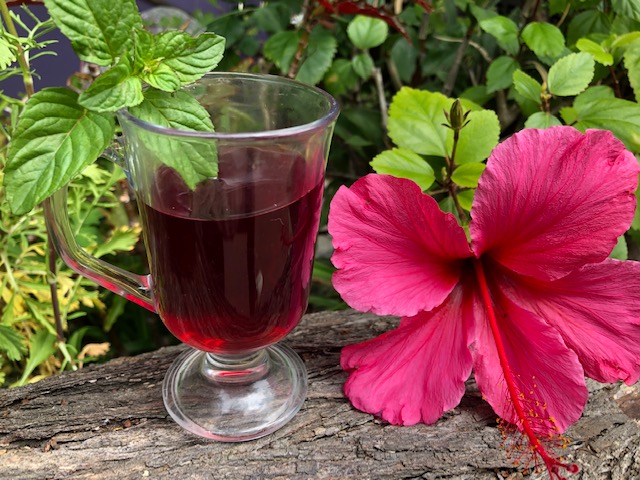
2)ペッパーミント
3)ローズマリー
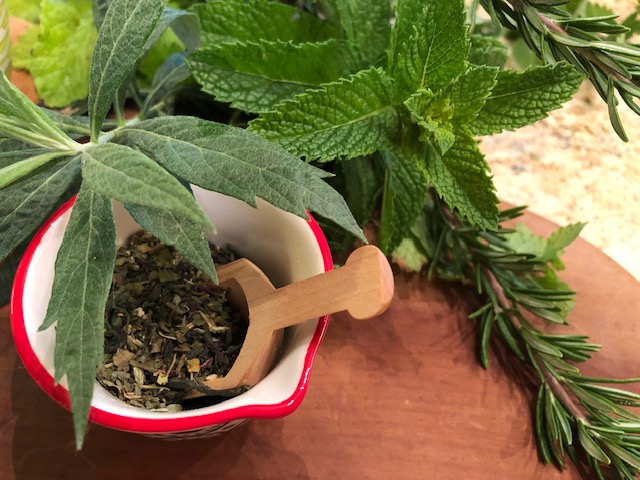
4)ホリーバジル
5)カレンデュラ
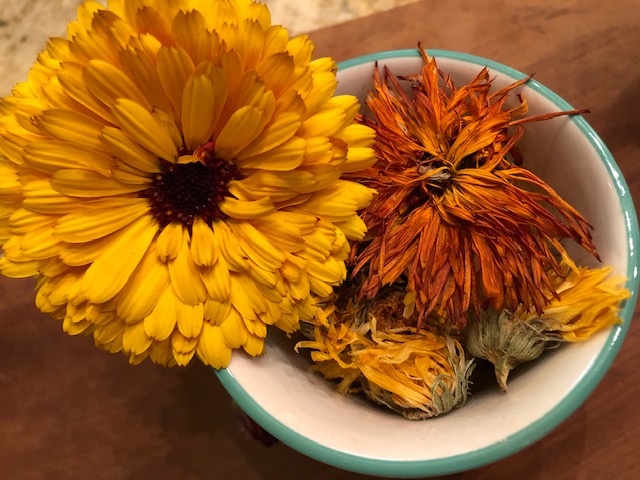
-免疫力を高める
-老化防止
-高血圧·コレステロール
-抗炎剤, 抗菌剤, 抗ウィルス, 抗うつ剤, 抗不安、抗腫瘍性、神経保護、-
-スキン、髪の毛などをサポート
その他
英語で詳しく説明はこちら
BENEFITS OF HERBS:
1) Hibiscus 🌺 (hibiscus sabdariffa) Family – malvaceae-mallow family Calyx
- Rich in antioxidants such as beta-carotene, vitamin C and anthocyanin.
- Fights inflammation, Lowers blood pressure. Lowers cholesterol, Promotes weight loss.
- Fights bacteria, Supports liver health and more
Taste: sour, naturally sweet, spicy, and fruity
Action: Anticatarrhal, anti-inflammatory, antimicrobial, antioxidant, astringent, cardiotonic, demulcent, diuretic, hepatic, hypocholesterolemic, immune stimulant, refrigerant, reproductive tonic
Energetics: cooling and drying, uplifting, strengthening, refreshing
Use: Traditionally, hibiscus calyces have been used throughout the world as “refrigerants” to cool the body (Engels, 2007). In Egypt, hibiscus has been used as a diuretic and for cardiac and nerve diseases; in North Africa for coughs and sore throats; in Europe for colds and upper respiratory tract congestion, sleeplessness, and as a laxative and diuretic; and in Iran for hypertension (Engels, 2007).
The sour, astringent, cooling nature of hibiscus helps to cool and regulate the body’s temperature, as well as tone and cool irritated tissue and mucous membranes throughout the digestive tract and genitourinary system. This is particularly indicated in the case of overheated states and inflammation in the body, such as irritation in the liver, stomach, bladder, urinary tract, uterus, or colon. Hibiscus is also clearing, helping to move stuck mucus
in the lungs and energy in the digestive, respiratory, circulatory, and reproductive systems.
Sauce from Herb Academy
2) Peppermint (Mentha x Piperita)
- Relieves gas and bloating while relaxing the digestive muscles and breaks up flatulence.
- Stimulates digestive juices and can ease nausea and motion sickness.
- Aids in colds, fevers, and flu.
Taste: sweetish odor and a warm, pungent taste with a cooling aftertaste
Action: carminative, anti-inflammatory, antispasmodic, aromatic, diaphoretic, antiemetic, nervine, anti-microbial, analgesic
3) Rosemary (Rosmarinus officinalis)
- Help alleviate muscle pain and improve memory.
- Boost the immune and circulatory system, and promote hair growth.
Taste: acrid & aromatic
Action: anti-microbial, anti-inflammatory, anti-oxidant, anti-apoptotic, anti-tumorigenic, anti-nociceptive, and neuroprotectiv
4) Holy Basil, Tulsi (rama – ocimum tenuiflorum)
- Calms the nervous system, moves stagnation, colds and flu, upper respiratory illness.
- Protects against toxicity from chemicals, heavy metals, and radiations.
Taste: robust, slightly sweet flavor and crisp taste
Actions: anti-inflammatory, anti-microbial, anti-viral, anti-fungal, anti-depressant, anti-anxiety
5) Calendula (calendula officinalis)
- Prevents muscle spasms, starts menstrual periods, and reduces fever.
- It is also used for treating sore throat and mouth, menstrual cramps, cancer, and stomach and duodenal ulcers.
Taste: Acrid, bitter, cool
Action: Anti-inflammatory, vulnerary, antiseptic
6) Lemon Balm (melissa Officinalis) Family: Lamiaceae
- Calming and uplifting the nervous system
- Relieves spasms and gas, hot water extracts have anti-viral properties
Taste: Acrid, bitter, cool
Actions: carminative, nervine, antispasmodic, antidepressant, diaphoretic, antimicrobial, antiviral, hepatic
Contraindication: hypothyroidism
7) Chamomile (matricaria recutita) Family: Asteraceae
- Calming to the nervous system, anti-inflammatory
- Calming to digestive cramping and gas upset, mild
Taste: flowery, earthy and apple-like sweetness
Actions: nervine, antispasmodic, carminative, anti-inflammatory(抗炎剤), antimicrobial, bitter, vulnerary
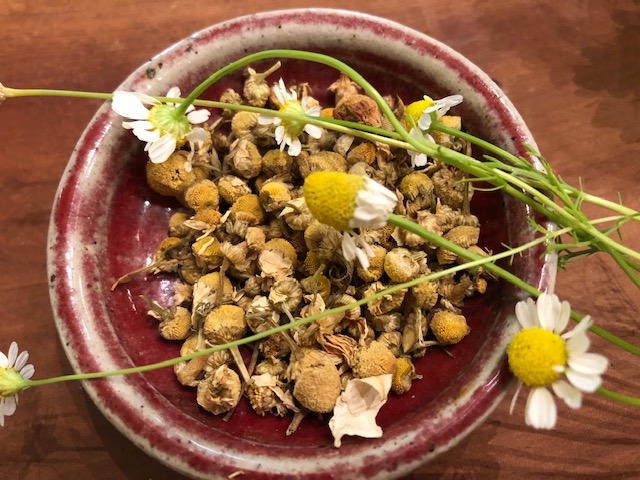
4. TIPS for GROWING MEDICINAL HERBS
(your garden or pots – you can even grow a lot in a small space!)
1) If you love/like gardening or are curious about gardening, you can grow medicinal herbs even in a small container if you do not have a garden and live in an apartment. I once grew them when I was living in the school dormitory.
2) If you have a small space, choose the one easy to grow and you want to make fresh herbal tea.
3) A connection you make with plants/herbs/nature is essential.
4) As you observe the cycle of season/nature/life by little, seeds sprout and grow to produce flowers and maybe seeds again.
5) Recognizing the cycle of life is natural healing.
6) Most medicinal herbs grow like weeds in the wild. They are pretty hardy, so they usually thrive when you give decent soil, light, and water.
5. HOW/WHEN to HARVEST
1) Buds and Flowers are best harvested just as they are opening.
2) Don’t wait for them to open fully: they will lose their medicinal potency.
3) Leaves are usually best harvested before a plant is in full bloom.
6. HOW TO PROPERLY DRY
- Once you’ve harvested medicinal herbs for future use, I recommend drying them to preserve them.
- Dried quickly, protected from direct sunlight, packaged, and stored correctly
- Minimal humidity and good airflow
- If you use a dehydrator: a temperature should be around 90º to 110º
- The traditional method for drying herbs is to hang them in small bundles from rafters.
7. FRESH VS. DRIED
- Fresh-picked herbs taste good, but high-quality dried herbs can be as effective as fresh herbs.
- The best reason to use dried herbs is that fresh herbs are unavailable year-round, and some medicinal herbs are not grown locally.
- When making salves and oils, it is better to use dried herbs because the water content in fresh plants can spoil the oil.
If you have a question, send me email sanaehealing@gmail.com or post here.
Thank you!

